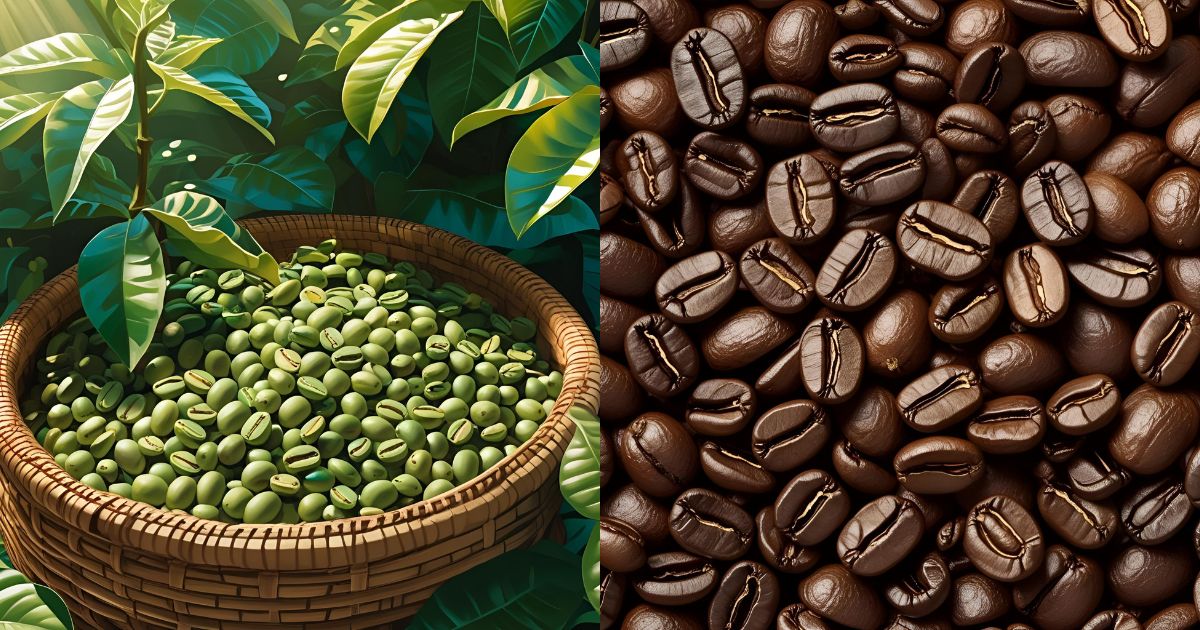Yemen green coffee beans are among the rarest and most sought-after coffees in the world.
Cultivated in the rugged highlands of Yemen, these unroasted beans carry centuries of heritage — from the ancient port of Mocha to today’s specialty roasters.
But finding authentic Yemeni beans like Matari, Haraaz, or Ismaili? That’s no easy task. Supply is limited, quality varies, and the market is full of imitations.
If you’re here, you’re likely after more than just beans — you’re chasing complexity, terroir, and a roast that tells a story.
In this guide, you’ll discover everything you need to know: the origins of Yemen’s coffee culture, the most prized varietals, how to source responsibly, and how to roast these gems to perfection.
Let’s unlock the secrets behind one of coffee’s most legendary origins.
History & Heritage of Yemeni Coffee
Yemen isn’t just a coffee origin — it’s the origin.
Long before Colombia or Ethiopia made headlines, Yemen was quietly cultivating Coffea arabica on its sunbaked mountainsides.
The legendary port of Mocha once shipped beans across the globe, giving rise to the term “mocha coffee.” This wasn’t just a trade route — it was the beginning of coffee as a global obsession.
In fact, the influence of Yemeni coffee reached far beyond the cup. It even inspired classical music, like Bach’s Coffee Cantata, a reflection of how deeply coffee had woven itself into culture.
From Alibaba to Condé Nast Traveler, sources agree: Yemen’s coffee history is unparalleled. It’s not just old — it’s authentic, rooted in centuries of tradition.
As Ottoman traders carried it to Istanbul, and merchants brought it into Europe, Yemen’s beans helped ignite the world’s caffeine revolution.
And today? That same ancient lineage lives on in the hills of Haraz, Matari, and Bani Matar.
Traditional Processing & Terroir
Yemeni green coffee still follows time-honored methods few other regions use.
Farmers dry-process their beans on rooftops and stone terraces, relying on intense mountain sunlight and generations of craft — not machines.
Unlike mass-produced coffee, each lot is small, unique, and sun‑kissed. It’s as close to wild coffee as you’ll ever find.
The country’s high-altitude terroir—often 5,000 to 7,000 feet above sea level—produces incredibly dense beans with complex flavors.
You’ll find heirloom varietals like Matari, Udaini, and Dwairi, each with their own story and sensory profile. No hybrids, no shortcuts.
This combination of elevation, dry-processing, and ancient genetics is what gives Yemen coffee its unmatched depth: earthy, fruity, spicy, and unforgettable.
Growing Regions & Key Varietals
Yemen’s coffee isn’t grown — it’s carved into the mountainside.
From the terraced fields of Jabal Haraz and Bani Matar, to the fertile valleys of Ta’izz, Ibb, and Hajjah, each region brings a distinct microclimate.
These are no factory farms. Farmers in Raymah and the Sana’a highlands grow small, traceable lots using methods passed down for centuries.
Places like Haraaz Cooperative® and Rayyan Mill lead the way in cooperative sourcing, making it easier for buyers to trace each bag of green beans to its origin — and its farmer.
These micro‑terroirs aren’t just marketing. They translate into flavor, ethics, and exclusivity.
Signature Varietals & Flavor Profiles

Yemen’s green coffee beans aren’t just rare — they’re wildly diverse.
Matari beans offer bold, full-bodied profiles with notes of dried fruit, chocolate, and tobacco.
Haraaz varietals lean fruity and floral — think raspberry, fig, and a hint of winey acidity.
Ismaili, Udaini, and Dwairi bring a rich, layered cup: spice, herbal undertones, and date-like sweetness.
Across the board, you’ll taste hallmarks like mocha, berry, earth, and spice — all grounded in a naturally full-bodied experience that no other origin can replicate.
This is terroir in its purest form — no washed processes, no synthetic inputs, just sun-dried brilliance and ancient beans from the highlands of Yemen.
Quality, Scarcity & Market Dynamics
Yemeni coffee is rare—and that’s not a marketing gimmick.
Most farmers in Yemen produce just 100–120 kg of green coffee beans per year. That’s less than a single commercial lot from farms in Brazil or Colombia.
The reason? Yemen’s terrain is rugged, water is scarce, and coffee is still grown and harvested by hand on ancient terraces. No automation. No shortcuts.
Ongoing conflict and political instability make things worse. Exports are inconsistent. Infrastructure is weak. Shipping delays are common.
As a result, prices are high—often 3–5x more than average specialty green coffee. But that price reflects not just scarcity—it reflects quality, tradition, and resilience.
If you’re buying Yemeni beans, expect to pay for exclusivity. And if you find them at a suspiciously low price? They’re likely blends, or not Yemeni at all.
Sourcing & Traceability
Want the real thing? Then traceability is everything.
Look for seed-to-cup partnerships that link each batch directly to smallholder farms or co-ops—like the Rayyan Mill or Haraaz Cooperative®.
These traceable supply chains ensure you’re getting 100% Yemeni green coffee beans, not mixed origins sold under a “Mocha” label.
Better yet, ethical sourcing ensures:
Farmers are fairly paid
No land is diverted to qat cultivation
Communities benefit from your purchase
Trusted partners like Al Mokha, Benchmark Coffee Traders, and Warfair prioritize direct trade, quality control, and social impact.
Buying Yemen Green Coffee Beans
When it comes to sourcing, go straight to the experts. Here are vetted options with a strong record of quality and transparency:
- Benchmark Coffee Traders – Offers micro-lots from Rayyan Mill with full traceability.
- Green Coffee Collective – Small-batch green beans, often sourced directly from Yemen.
- Al Mokha – Focuses exclusively on Yemeni coffee; known for mission-driven sourcing.
- Coffee Bean Corral – Carries a rotating selection of Yemeni varietals with detailed origin data.
- Warfair – Partners directly with farmers to ensure ethical sourcing.
Pro Tip: If a product doesn’t list varietal, region, or cooperative—it’s not worth the risk.
Comparing Grades & Packaging Sizes
Yemeni green coffee is often sold in micro-lots—small, curated batches sorted by quality.
You’ll see options like:
100g–250g sample packs (perfect for home roasters)
1–5 lb bags for small batch roasting
Bulk sizes (25–46 lb) for pros or cafes
Each size tier comes with different freshness, pricing, and shipping conditions.
Buying tip:
Retail buyers: Stick with 100–500g. Use fast.
Roasters or businesses: Go bulk, but confirm lot ID and packaging date.
Shipping, Customs & Storage
Getting green coffee across borders requires a bit of planning.
- Shelf Life: Green beans last 6–12 months if stored properly. Keep them in cool, dry places away from light.
- Humidity Control: Use airtight containers or vacuum seals to avoid mold or moisture loss.
- Shipping Notes: Some vendors include customs clearance in price. Others require import duties—especially on bulk orders.
Roasted beans lose flavor fast. But Yemen green coffee beans, if stored well, give you the flexibility to roast fresh whenever you want.
Read Also:
👉 Geisha Green Coffee Beans
👉 Green Coffee Beans by Region Map
Roasting & Brewing Guide
Yemen green coffee beans are complex. The roast you choose brings out different dimensions of that complexity.
For floral notes and fruity acidity, go light to medium-light. This preserves the natural wine-like brightness from regions like Haraz and Ismaili.
Prefer chocolate, spice, and heavier body? Try a medium to medium-dark roast, especially with Matari or Bani Matar beans.
Roasting Yemeni beans isn’t about extremes. It’s about balance—highlighting the bean’s unique terroir without overpowering it.
Home Roasting Tips
You don’t need a commercial setup to roast Yemeni beans—just the right tools and attention to detail.
Start with basic equipment:
A home roasting machine (like a Fresh Roast SR540)
A popcorn popper (budget option)
Cast iron pan (for traditionalists)
Key roasting tips:
Batch size: Start with 100–150g to control heat and development
Listen for first crack (for lighter roasts) and second crack (for darker roasts)
Watch for color shifts—Yemeni beans often go from olive green to light cinnamon, then deeper chestnut
Smell is crucial: fruity and floral notes peak just after first crack
Cool beans fast using a metal strainer or fan to stop further roasting
Track every batch. Yemeni beans vary by region, so one roast curve won’t fit all.
Best Brewing Methods
Once roasted, brew to highlight clarity and complexity.
Top brewing methods for Yemen coffee:
Pour-over (V60, Chemex): Best for floral and fruit-forward roasts
Drip machine: Convenient and consistent
Traditional Yemeni Dallah: Coffee brewed with cardamom and spices—especially great with medium-dark roasted Matari
Use filtered water, a medium-fine grind, and a 1:15 ratio (coffee:water) for balance and extraction.
Cultural Significance & Traditional Uses
In Yemen, coffee isn’t just about the bean—it’s about the whole fruit.
Qishr is a traditional tea made from the husks of dried coffee cherries (cascara). It’s brewed with ginger, cinnamon, and sometimes cloves.
This lightly caffeinated drink is:
Fragrant and spicy
A staple in social gatherings
Still widely consumed in Yemeni homes today
You can buy Qishr blends or make your own from sun-dried Yemeni coffee husks.
Storytelling & Branding
Every bean carries a story. Yemen’s coffee revival is powered by people like Mokhtar Alkhanshali, who brought global attention to Yemen’s farmers through his brand and the book The Monk of Mokha.
Buying Yemen green coffee beans isn’t just a transaction—it’s a connection to centuries-old farming, civil resilience, and cultural pride.
Brands that lead with storytelling—like Al Mokha, Rayyan Mill, and Warfair—are helping reshape how the world sees Yemen: not just a conflict zone, but a birthplace of specialty coffee.
Conclusion
Yemen green coffee beans aren’t just rare—they’re legendary.
From hand-built mountain terraces to sun-drying rooftops, every step of their journey is rooted in tradition, hardship, and exceptional quality.
When you buy and roast Yemeni beans, you’re tasting history. You’re supporting farmers who grow coffee the way it’s been done for centuries—without compromise.
FAQ
What are Yemen green coffee beans?
They are unroasted, heirloom Arabica beans grown in Yemen’s highlands—hand-picked, sun-dried, and known for bold, complex flavor.
How do Yemeni beans differ from Ethiopian or Costa Rican origins?
Yemen beans are dry-processed, often spicier and more wine-like, with earthy undertones. Ethiopian beans lean floral and citrusy, while Costa Rican beans are cleaner and brighter.
What flavor notes can I expect?
Look for dried fruit, mocha, red wine acidity, spice, and full body—depending on the roast and origin (Matari, Haraaz, etc.).
How long do they last and how to store?
Green beans stay fresh for 6–12 months if stored in a cool, dark, dry place—preferably in an airtight container.
Where to buy small quantities legally shipped to my region?
Check trusted vendors like Coffee Bean Corral, Benchmark Coffee Traders, or Al Mokha. Many ship internationally with customs support.
How to roast to maximize flavor?
Use a light or medium roast to preserve fruity, floral notes. Always cool beans quickly and roast in small batches for best control.

Mahian has an insatiable curiosity for discovering unique coffee beans and exploring global café trends. He delves into the stories of coffee origins, packaging innovations, and the evolving landscape of café culture. Mahian’s contributions provide readers with a broader perspective on the world of coffee.

